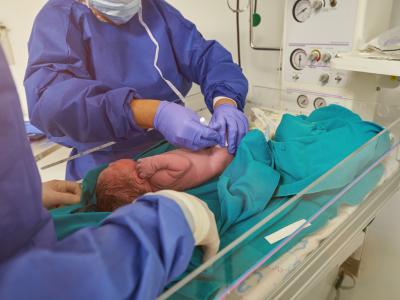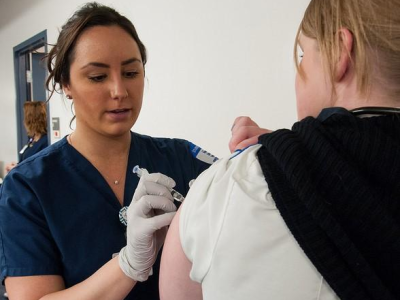Our weekly wrap-up of antimicrobial stewardship & antimicrobial resistance scans
Study finds rising use of antibiotics in Chinese hospitals
Antibiotic use in Chinese hospitals rose by nearly 40% from 2011 through 2018, with a troubling rise in the use of last-resort antibiotics, according to a study this week in Antimicrobial Resistance and Infection Control.
In the study, researchers from Peking University analyzed aggregated monthly antibiotic procurement records from 586 hospitals in 28 provinces. Information included the generic antibiotic name, procurement amount, dosage form, strength, route of administration, and geographic data. Antibiotic use was expressed in defined daily doses per 1,000 inhabitants per day (DID). The researchers also used the Watch, Access, and Reserve antibiotic categories established by the World Health Organization (WHO) to analyze antibiotic use.
From 2011 through 2018, total antibiotic use in China's hospitals increased by 39.6% (from 4.8 DID in 2010 to 6.7 DID in 2018). Antibiotic use was stable or moderately decreased in 13 provinces, while in the other 15 provinces it substantially increased. Cephalosporins were the most consumed antibiotics, accounting for 26.9% of the total antibiotic use (1.8 DID/6.7 DID). In 2018, antibiotics in the Access category accounted for 19.4% of the total use (1.3 DID/6.7 DID), while antibiotics in the Watch category made up the largest proportion—71.6% (4.8 DID/6.7 DID). The most important relative increase observed during the study period was in the use of carbapenems (233%, from 0.03 DID to 0.1 DID).
Population-weighted antibiotic use was greater in secondary hospitals than in tertiary hospitals (7.3 DID vs 6.6 DID). The use of oral antibiotics was almost twice as high as parenteral antibiotic use in secondary hospitals, whereas in tertiary hospitals the amounts were about the same.
The authors of the study note that the results show that antibiotic consumption in Chinese hospitals is more than triple the average level of antibiotic consumption in 24 European Union/European Economic Area countries (2.0 DID in 2017). The increase comes despite efforts by the Chinese government to limit antibiotic use.
"The increase of antibiotic utilisation, especially the increase of last-resort antibiotics raises serious concern for public health," they wrote. "Current patterns of antibiotic utilisation demonstrated that gaps are existed towards the global target set up by the WHO. To better facilitate proper antibiotic use, more efforts are needed to explore the appropriateness of antibiotic use at the individual level."
Apr 15 Antimicrob Resist Infect Control study
Study highlights spread of C auris in skilled nursing facilities
Originally published by CIDRAP News Apr 15
Point prevalence surveys at high-acuity long-term care facilities in Chicago indicate that ventilator-capable skilled nursing facilities (vSNFs) are particularly vulnerable to Candida auris, a research team led by the Chicago Department of Public Health reported yesterday in Clinical Infectious Diseases.
The surveys were conducted from August 2016 through December 2018 to identify patients colonized with C auris and assess infection control (IC) measures in the city's high-acuity long-term care facilities, where ongoing spread of the pathogen has been documented since the first two cases of the multidrug-resistant fungus were identified in Chicago in August 2016.
The 47 surveys conducted in 18 facilities identified 490 patients infected (128) or colonized (362) with C auris, and found that the highest prevalence of C auris colonization was in vSNFs (median prevalence, 66%) and long-term acute care hospitals (median prevalence, 31%). IC assessments identified lack of staff member time dedicated to IC activities, lack of infection surveillance systems, and lack of personal protective equipment as common challenges.
A case study and repeat point prevalence surveys conducted at a single vSNF from January 2018 through October 2018 found that C auris prevalence increased from 43% to 71% over 10 months, that most residents remained persistently colonized with C auris, and that 39% of environmental samples collected tested positive for the pathogen. C auris was detected in samples collected from over-bed tables, bedside chairs, nursing carts, doorknobs, bedrails, and windowsills.
"High-acuity long-term healthcare facilities represent high priority settings for public health interventions to contain spread of emerging healthcare-associated MDROs [multidrug-resistant organisms]," the researchers wrote. "Strategies are needed to improve adherence to infection control practices."
According to the most recent case count from the US Centers for Disease Control and Prevention (CDC), there are 1,018 confirmed and probable C auris infections in 16 states, and an additional 2,051 patients who are colonized. Illinois has the second-highest number of cases, at 292, behind New York (465).
Apr 14 Clin Infect Dis abstract
Feb 2 CDC C auris case count
CDC researchers find MDR Salmonella strain in US travelers
Originally published by CIDRAP News Apr 15
In a research letter today in Emerging Infectious Diseases, CDC researchers reported the identification of a strain of multidrug-resistant (MDR) Salmonella previously found in Taiwan among US patients with a history of travel to Asia.
Using the National Center for Biotechnology Information Pathogen Detection Isolates Browser—a database of bacterial isolates from patients, food, and the environment—the researchers analyzed the genome sequences of 37 isolates genetically related to Salmonella enterica serotype Anatum, an MDR Salmonella strain that emerged in Taiwan in 2011.
Twenty-five of the isolates were from Taiwan, and 12 were from the United States, including 7 from people, 4 from tilapia imported from Taiwan, and 1 from shrimp imported from the Philippines.
The isolates harbored 11 antibiotic resistance genes, including blaDHA-1, a plasmid-mediated AmpC beta-lactamase gene, and the MCR-1.1 colistin-resistance gene. Antibiotic susceptibility testing indicated resistance to multiple antibiotic classes, including three recommended for treating Salmonella infections.
All 7 US patients reported diarrhea, abdominal pain, nausea, and fever, and 4 became ill after returning from the Philippines. Two others travelled to the Philippines and Taiwan, but travel and illness onset dates were not available. One patient had never travelled internationally, but her isolate was genetically similar to the isolate from shrimp imported from the Philippines. Before illness onset, she ate shrimp at an Asian restaurant.
"Our findings underscore the need for global, One Health surveillance," the authors write. "Given the extent of international travel and trade, data sharing among human health, animal health, and food production sectors and across geographic borders is essential to detect MDR strains and inform strategies and interventions to prevent spread."
Apr 15 Emerg Infect Dis study
Study: Diagnostic stewardship tied to benefits for C diff testing
Originally published by CIDRAP News Apr 13
Applying diagnostic stewardship to molecular testing for Clostridioides difficile infection (CDI) at a hospital system in California was associated with to a significant reduction in testing, cases, and costs, researchers reported today in Infection Control and Hospital Epidemiology.
In the multicenter study, researchers at Scripps Mercy Hospital in San Diego evaluated two 6-month periods before and after an intervention at the four-hospital Scripps Healthcare system in which polymerase chain reaction (PCR) testing for C difficile had to be separately ordered by a clinician if enzyme immunoassay (EIA) test results were indeterminate.
Prior to the intervention, the hospital system's C difficile testing algorithm reflexively ordered PCR tests as a "tie breaker" in indeterminate cases, but PCR tests can lead to overdiagnosis because they don't distinguish between C difficile colonization and active infection. The primary outcome of the study was the change in the number of CDI diagnoses between periods, and secondary outcomes included the number of PCR tests performed, adverse events, and healthcare cost savings.
In total, 500 EIA-indeterminate C difficile test results were evaluated: 281 before the intervention and 219 thereafter. CDI was diagnosed by PCR among EIA-indeterminate cases in 182 (64.8%) in the preintervention period versus 94 patients (42.9%) in the postintervention period (48.4% reduction; P < .01). PCR testing was performed in 99.6% of indeterminate cases (280 of 281) in the preintervention period versus 65.8% (144 of 219) in the postintervention period (33.8-percentage-point reduction; P < .01). Researchers observed no differences between study periods in 30-day all-cause (P = .96), gastrointestinal illness-related (P = .93), or C difficile (P = .47) hospital readmissions, nor in 30-day C difficile infections (P > .99).
No patient without a PCR test in the postintervention period and not treated was later diagnosed as having CDI. Each reflexive PCR test not performed led to a cost savings of $4,498 per patient.
"The study results presented here highlight the importance of diagnostic stewardship in ordering C. difficile PCR tests in the inpatient setting and the benefits of a simple change from reflexive to clinician-required ordering for PCR testing among EIA antigen+/toxin− cases," the researchers write.
Apr 13 Infect Control Hosp Epidemiol abstract
Quality improvement linked to appropriate prescribing in Scotland
Originally published by CIDRAP News Apr 13
Prescribing of gentamicin and vancomycin in Scotland improved following the development of revised guidelines and other quality improvement (QI) resources, Scottish researchers reported recently in the Journal of Antimicrobial Chemotherapy.
The QI resources were developed by five pharmacists in collaboration with Scottish antimicrobial stewardship teams following studies in 2011 that showed the limitations of national guidance on gentamycin and vancomycin prescribing introduced in 2009. Among the findings of those studies were that only 44% of gentamicin dosage recommendations and 55% of vancomycin dosage recommendations were in accordance with the guidelines, that the existence of guidelines alone was insufficient to ensure appropriate prescribing and monitoring, and that poor communication, unmet educational needs, and inappropriate staffing were some of the obstacles.
Through a series of meetings, workshops, and face-to-face discussions, the team developed revised guidelines, online and mobile dose calculators, educational material, and specialized prescribing and monitoring charts that were implemented from 2013 through 2016. An online survey conducted in 2017 found that 80% of the Scottish health boards that responded (12 of 15) were using the revised guidelines, electronic calculators, and gentamicin prescription chart (8 used the vancomycin chart).
A before-and-after point prevalence study to evaluate the impact of the QI resources found that, from 2011 to 2018, the percentage of patients who received the recommended dose of gentamicin increased from 44% to 89% (odds ratio [OR], 10.99; 95% confidence interval [CI], 6.37 to 18.95). For vancomycin, the correct loading dose increased from 50% to 85% (OR, 5.69; 95% CI, 2.76 to 11.71) and the correct maintenance dose rose from 55% to 90% (OR, 7.17; 95% CI, 3.01 to 17.07).
"Strong leadership from a dedicated team of healthcare professionals in collaboration with national and local multidisciplinary networks facilitated the success of these developments," the authors of the study write. "This improvement methodology could be adapted for other areas of prescribing practice with the aim of improving the use of antimicrobial prescribing at scale within the hospital setting."
Apr 11 J Antimicrob Chemother abstract













